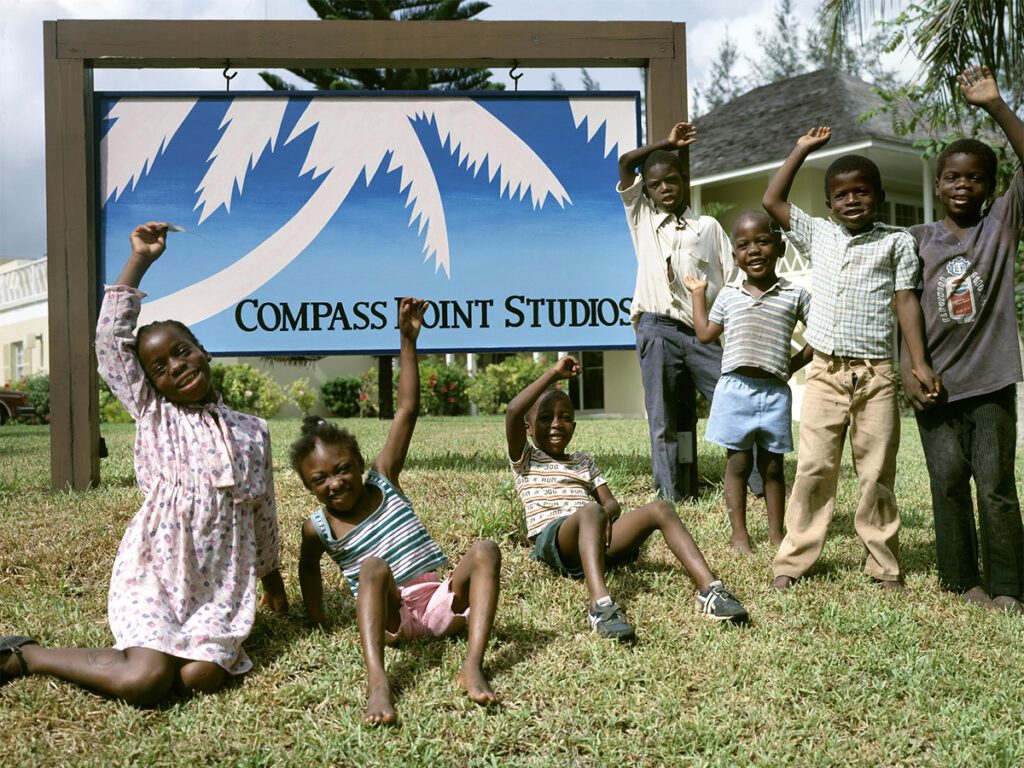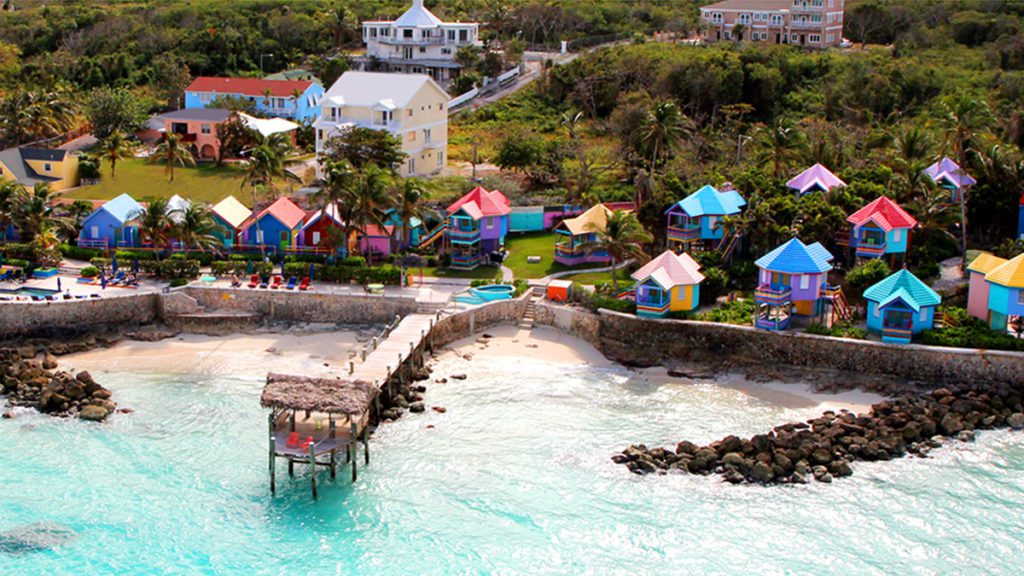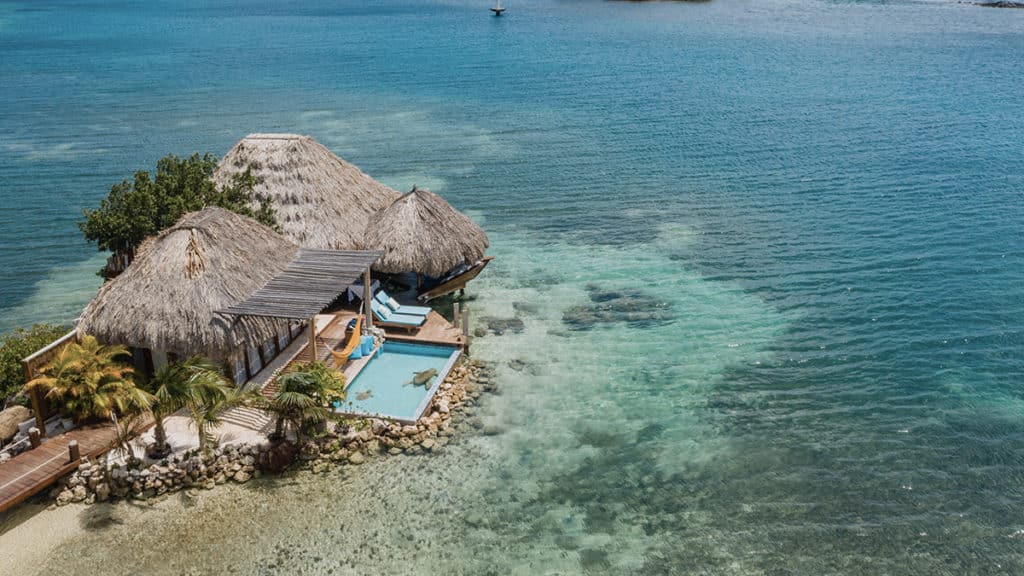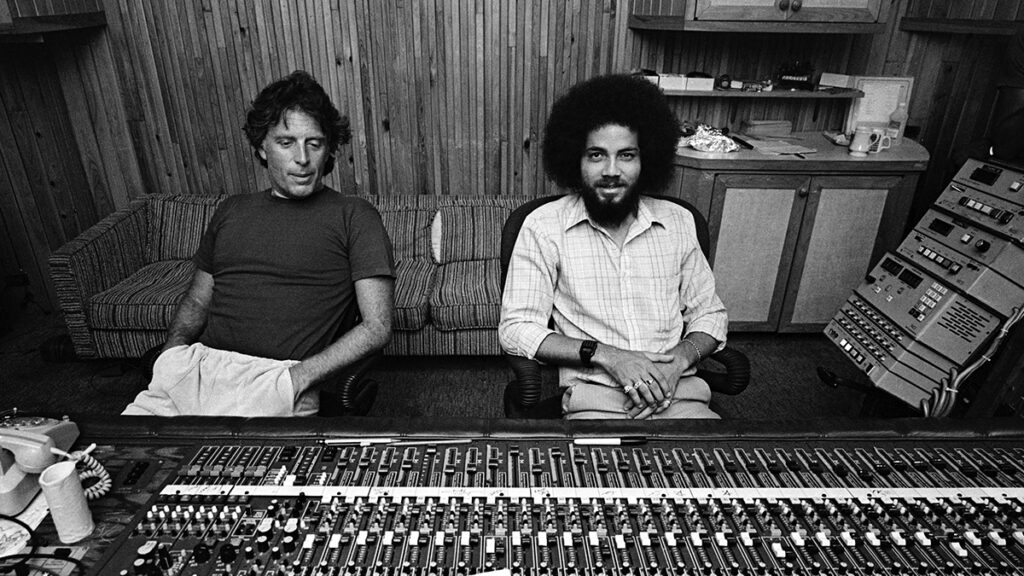Back in Black, AC/DC’s 1980 comeback record, was a spectacular success for the Australian hard rock band, selling more than 50 million copies worldwide to become one of the top-selling albums of all time.
But for all of its commercial success, Back in Black isn’t even the most important record recorded at Compass Point Studios in the Bahamas.
Between roughly 1977 and 1987, Compass Point, founded by legendary producer Chris Blackwell, was arguably the center of the musical world.
It’s the place where Grace Jones made the transition from fashion model to iconic 80s musician and movie star. Where the B-52s recorded their debut album. Where the Talking Heads made their most acclaimed record, Remain in Light. And where artists as diverse as Madness, Iron Maiden, Black Uhuru and Robert Palmer cut tracks under the tropical sun, sometimes with the able assistance of the studio’s in-house band, which came to be known as the legendary Compass Point All-Stars.
It all happened in a nearly forgotten complex of studios and colorful cottages on the outskirts of Nassau that’s currently slated for demolition to make way for a residential housing complex.
The wrecking ball is a sad coda for Compass Point, which sprung to life in 1977 when the Jamaican-born Blackwell — founder of Island Records and already famous for introducing the world to reggae music, discovering the Spencer Davis Group and Steve Winwood, and producing albums by groups like Traffic, Emerson Lake and Palmer, and Jethro Tull — decided he wanted to open a studio of his own.
“I had a house in Nassau and thought it could be a good idea to build a studio there because it was an easy place to get in and out of,” said Blackwell. “It was a small community, and you didn’t have a lot of people hanging around outside the studio like you would in New York or Jamaica. I thought it would be really helpful if bands had an environment where they would not be disturbed.”
Enlisting a young American engineer named Alex Sadkin to run the studio — “really the best person I ever worked with” — Blackwell opened Compass Point in 1977. The laid-back concept, along with his own star power, lured some of the top performers in the world to Nassau, including Mick Jagger, who recorded his 1985 solo album, She’s the Boss, and Joe Cocker, who made Sheffield Steel at Compass Point in 1982.
“We were the first band to make an album there,” said Chris Frantz, drummer for Talking Heads, who headed to Compass Point with producer Brian Eno in 1978 to record More Songs About Buildings and Food, which contained the band’s first major hit song, “Take Me to the River.” Talking Heads would return to Compass Point to record two more albums, while Frantz and bassist Tina Weymouth not only recorded their two hit Tom Tom Club records in Nassau but also used Compass Point while producing albums for Ziggy Marley and Argentine band Los Fabulous Cadillacs.
“It was a very good vibe,” said Frantz. “The staff was mostly Bahamian and very pleasant and easy to get along with. It was like being in a little village. We did a lot of our best stuff there, and a lot of that had to do with Chris Blackwell. He knew how to run a studio, and even if he was off island a lot, he had people working there who knew what was expected.”
Compass Point wasn’t exactly distraction-free — there was still plenty of booze and drugs to be had — but overall Blackwell got what the creative ferment he wanted. A key addition came in 1980, when the producer assembled a diverse house band that would come to define the Compass Point sound and help create the underlying vibe that would permeate the studio for most of the next decade.
The Compass Point All-Stars were entirely Blackwell’s idea — but for once, the producer had no clear vision of what he wanted. Predictably, he started with reggae, recruiting Island recording artists drummer Sly Dunbar, bassist Robbie Shakespeare, guitarist Mikey Chung, percussionist Sticky Thompson, and Wailers keyboardist Tyrone Downie.

But from there it got weird, with Blackwell adding British guitarist Barry Reynolds, who had worked with Mariann Faithfull, and French-African musician Wally Baderou.
“To be blunt, I hated it,” said Baderou, who has been working on early electronic music (including the seminal “Pop Music” by M) and has no clear idea of what his role at Compass Point was supposed to be.
“I swore to god I would never go back to Nassau. I was happy to just do what I had to do and go back to Paris,” he said. “But we managed to discover each other and go on this incredible journey.” Baderou ended up staying in Nassau for 14 years, longer than almost anyone else involved in Compass Point Studios.
“It started off not very well, which was my fault because I didn’t tell them what I was doing,” admitted Blackwell, who said the Jamaicans and Europeans didn’t quite jell at first. “I was lucky — it could have gone very far south. I knew the five guys from Jamaica were solid, but the two others just added something special.”
“The first track we did down there I didn’t click with the Jamaicans and Wally could barely speak English at the time,” said Reynolds. “But the first time we played Warm Leatherette with Grace Jones, it was like magic. The band was so good because everyone was hearing everyone else and playing around everyone else. We locked into that reggae groove.”

(Thompson also helped break the tension by pretending to challenge Reynolds to a fight over some purloined cigarettes, then admitting he was joking when the two stepped outside the studio.)
Baderou recalled a similar bonding taking place when the band recorded Jones’ cover of the Pretenders “Private Life” for her first post-disco record. The success of the Warm Leatherette album also “started to get the word out and get people thinking they should come down to the Bahamas,” said Blackwell.
“Magical” is how Blackwell also recalls the vibe in the studio, as the All-Stars laid down reggae influenced beats for everyone from Cocker to the Tom Tom Club and resident artists like Robert Palmer, whose own music would transition from reggae-influenced rock to synth-pop hits like “Addicted to Love.”
“Compass Point was a joy,” said Reynolds. “It was one of most fun times I had recording. You could have a good time, but we knew we were on call 24 hours a day.”
Not everything that happened at Compass Point turned to gold like Palmer’s 1985 Riptide album, which peaked at #8 on the Billboard charts. “The dumbest thing I did was bring down James Brown,” recalled Blackwell. “He was like a god to me, but it didn’t work at all — he and the Jamaicans just didn’t connect.”
Blackwell counts the first album recorded by Grace Jones among his favorite memories of recording at Compass Point, recalling being enraptured by the Jamaican artist after hearing her perform “La Vie En Rose” over the sparse recording of a drum machine. “I loved the sound of her voice and how she looked and I gave her the money she wanted to make the record,” he recalled.
When the B-52s came to Compass Point in 1978 to record their self-titled debut album, Blackwell recalled that Bahamian customs agents, who normally imposed steep duty fees on imported instruments so they would not be resold, let the band slip by unmolested. “The instruments they brought were all like children’s toys,” he recalled with a laugh.
Blackwell said the band, barely removed from a communal crash pad in upstate New York, was “hilarious,” and B-52s singer Kate Pierson said the band “couldn’t have had a better start, because Chris Blackwell is a genius.”
In typical island style, Blackwell picked up the band in a Jeep at the Nassau airport and headed directly to a bar for a round of tropical cocktails, said Pierson. “We eventually found the studio,” she laughed. “It was just beautiful there; we hung out with Chris Frantz and Tina Weymouth, Chris Blackwell was a gracious host, and it was just a relaxed vibe.”
It was Blackwell’s choice to “record us just like we sound on stage,” said Pierson, capturing the energy that made the band first a cult favorite, and later mainstream stars. “There were many times where Chris would just put his feet up on the console, light a big joint and tell us to just go do our thing.”
“For us, it was like going to paradise,” she said. “The water was beautiful, Grace Jones and Robert Palmer were there. We were so nervous and tense, and it just helped relax us.”
Compass Point continued its strong run under Blackwell until 1987, when Alex Sadkin was killed in an automobile crash in Nassau. “He was a brilliant guy,” said Blackwell. “Honestly, when that happened it siphoned off the whole thing for me. He was the person who made Compass Point what it was, made it a great place for people to come and record.”
Compass Point did experience a brief revival in the 1990s, when Blackwell hired Terry and Sherrie Manning to manage the studio; the husband and wife team remodeled the studio and worked with a variety of top-tier performers, including Celine Dion, Sade, and Bjork, before shuttering the studio for good in 2010.
Today, little remains to remind visitors of the studio’s heyday in Nassau. For many years, the Compass Point Beach Resort utilized the colorful cottages on the studio grounds, which once housed visiting artists, as guest accommodations. But owner Leigh Rodney announced in May 2022 that he was closing the resort and its restaurant, with plans to convert the property to residences.
Frantz, who still owns a condo at Compass Point and returns there with Weymouth to vacation every winter, says there are still a few totems of the area’s musical history, notably the Studio Cafe located in the former Compass Point Studios building.
“It’s a nice place to have lunch, and they play up the fact that it used to be the recording studio,” said Frantz. “It’s also one of the few places in Nassau that is LGBTQ friendly.” The Travellers Rest restaurant and bar, where Reynolds once hung out with Eric Clapton and his band, is also still around.
Besides Sadkin, other people who made Compass Point spin, like Robert Palmer, Joe Cocker, and All-Stars Shakespeare, Chung, Tompson, and Downie, have passed away. The physical structures at Compass Point may likewise be vanishing, but the memories persist for Blackwell and the others who worked and recorded there.
“I can get very nostalgic and sad about it, but I try not to,” said Frantz. “It was very romantic: I had never been to a tropical island before I went to Nassau in 1978. It was a lot of long hours working hard, but we also were like pirates sailing to deserted islands.”
“We were never aware that we were creating something that people would be talking about 30 or 40 years later,” said Baderou. “It ended up being sort of a Nashville in the Caribbean. There was a sense of collaboration that Chris Blackwell was spreading around with his charisma.”
“It was a wonderful time,” said Blackwell. “It was fun, fresh, and new.”
Delta Is Adding More Daily Nonstop Flights to Aruba

